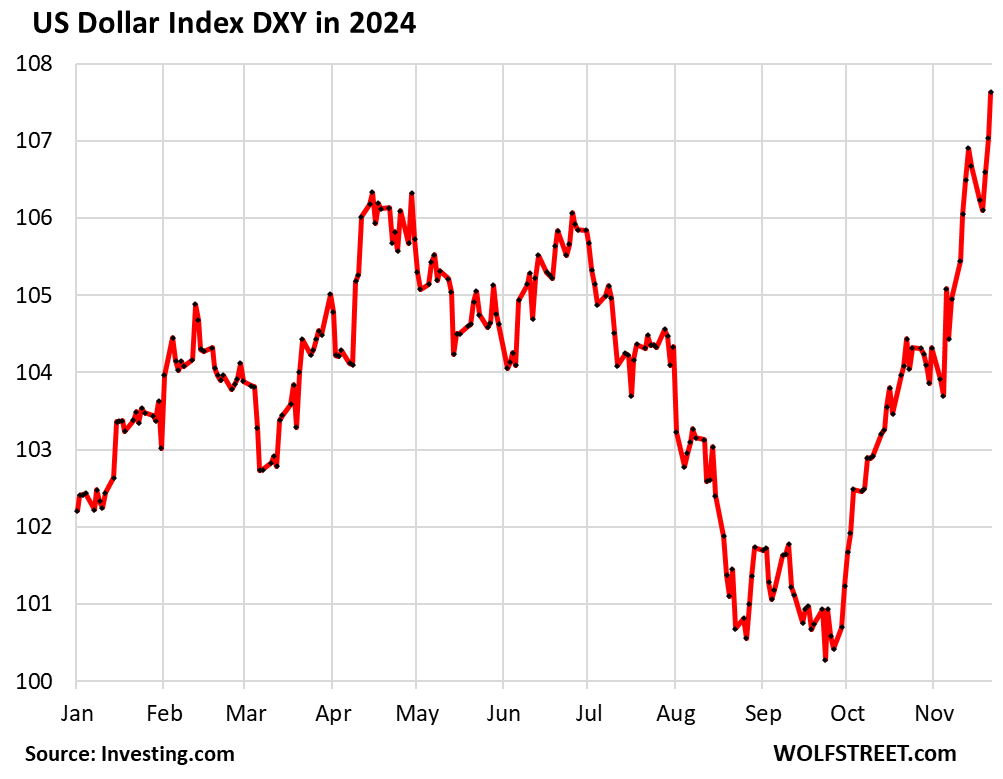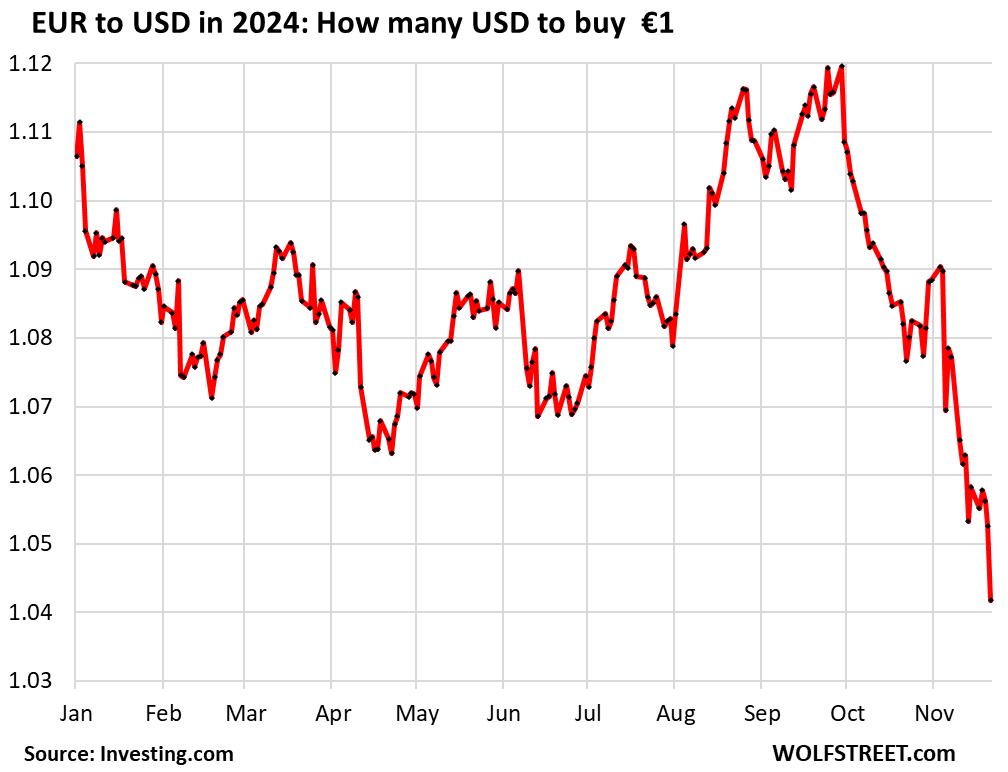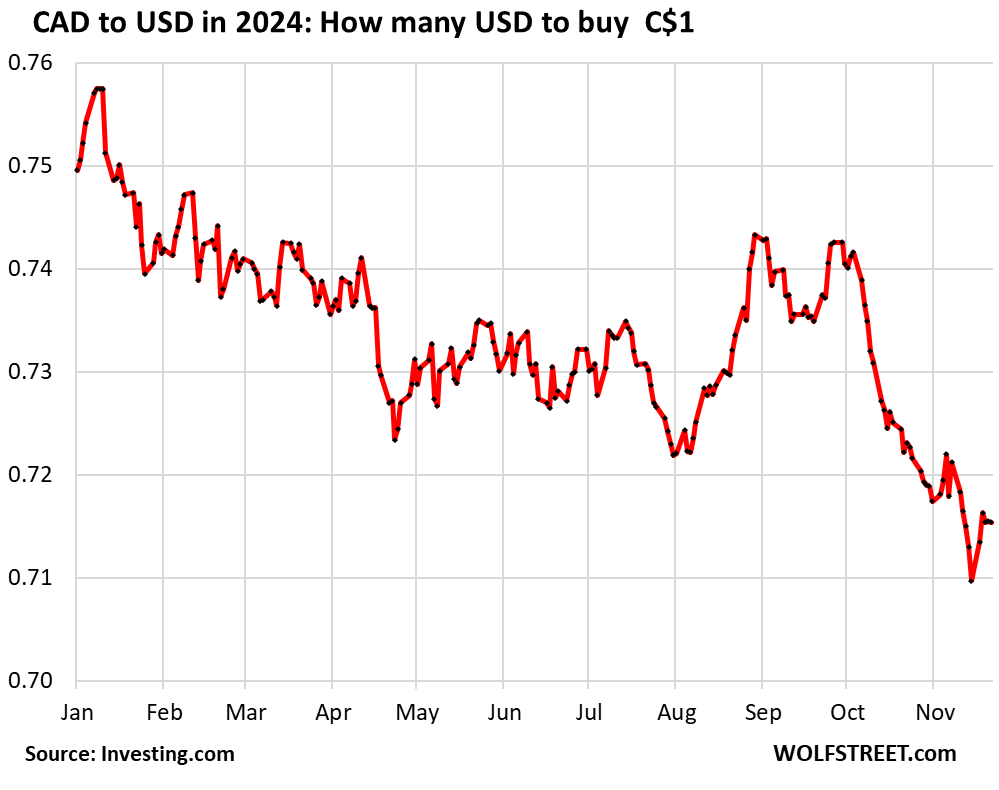
By Wolf Richter for WOLF STREET.
The Dollar Index [DXY] which tracks the USD against a basket of six currencies (euro, yen, Canadian dollar, British pound, Swedish krona, and Swiss franc) dominated by the euro and the yen, rose to 107.6 at the moment, the highest level in two years.
Over the past two months since the Fed started to furiously backpedal on the pace of its rate cuts, it has risen by 7.3%:

The US dollar has been on a rampage against other currencies since late September when the Fed, after its monster rate cut on September 18, started talking of smaller and fewer rate cuts to end at a higher level than previously priced in, after it became clear that the US labor market was growing solidly after all, that inflation was showing early signs of re-accelerating, that economic growth continued to run well above the 15-year average, powered largely by consumers, who in recent years got big increases in incomes and saved a bunch too, while their piles of interest-earning cash have ballooned, which they could spend in the future.
And this occurred while other central banks – in our case here, the ECB, the Bank of Japan, and the Bank of Canada – have out-dove’d the Fed by far:
- The Fed has cut by 75 basis points, to 4.75% at the top of its policy rates.
- The ECB has cut by 100 basis points to 3.4% and has indicated that it will continue to cut despite stubbornly high services inflation and surging wages.
- The Bank of Canada has cut by 125 basis points to 3.75% and has indicated that it will keep cutting.
- The Bank of Japan hiked by two minuscule notches, from negative to +0.25%, despite inflation rates that are similar to those in the US, leaving real yields of government securities deeply negative. It said it may hike again after wussing out before.
The ECB’s and BOC’s cuts have widened the spread between their policy rates and the Fed’s policy rates. And the spread is now expected to widen further.
The much higher yields of USD-denominated securities, such as Treasury securities, make them a juicy target for foreign investors, and they’ve backed up their trucks and are loading up. This demand for USD-denominated securities and the higher yields expected for them in the future is very supportive of USD exchange rates.
The 10-year yields for government securities makes that clear:
- US: 4.41%
- Canada: 3.46%
- Germany: 2.25%
- Japan: 1.08%.
The euro has dropped by 7.0% against the USD since late September, trading today at $1.042, the lowest since November 2022.
The Euro Area economy is growing slowly, with growth stalling in some countries. Germany has been wobbling quarter to quarter between slight growth and slight decline for the past two years. GDP for the year of 2023 dipped a tad, and 2024 looks similar so far. Despite fears about core inflation, and especially stubbornly high services inflation, the ECB has said it will keep cutting. And the euro dives:

The Canadian dollar has been wobbling lower all year against the USD as the BOC has been focused on cutting rates. Economic growth slowed sharply in 2023. Over the past seven quarters, the economy booked two negative quarters and one near-flat quarter. The rest showed modest growth. Over the first half this year, GDP growth picked up a little. Q3 GDP has not been released yet.
By the end of last week, the CAD had dropped to 0.709 USD, the lowest since June 2020. It currently trades up a little from there, at 0.715 USD. Since late September it has dropped 3.7%. Since mid-January, it has dropped by 5.5%.

The BOJ is in a category of its own, crushing its currency. Inflation in Japan is running at similar rates as in the US. But the BOJ has vowed to do the absolute minimum as late as possible, too little too late being already too much too fast. Earlier this year it finally ended QE and a few months ago started QT, trimming its gigantic balance sheet in baby steps. This attitude of “too little too late being already too much too fast” has been going on for two years, and as a result the yen has gotten slaughtered.
The yen currently trades at 154.7 yen to the USD, on its way back to the levels of July when it had plunged to 161.5 to the USD.
Rather than changing monetary policies to prevent the wholesale slaughter of the currency, authorities have been trying to jawbone markets, and that’s essentially useless except for day-traders. And authorities have periodically been blowing tens of billions of dollars to buy yen, but those massively costly efforts to prop up the yen were only briefly effective, before the yen re-plunged, as we can see in the chart.
Since the Fed started talking about hiking rates in September 2021, the yen has plunged by 30% against the USD.

Enjoy reading WOLF STREET and want to support it? You can donate. I appreciate it immensely. Click on the beer and iced-tea mug to find out how:
Would you like to be notified via email when WOLF STREET publishes a new article? Sign up here.
![]()
Energy News Beat

